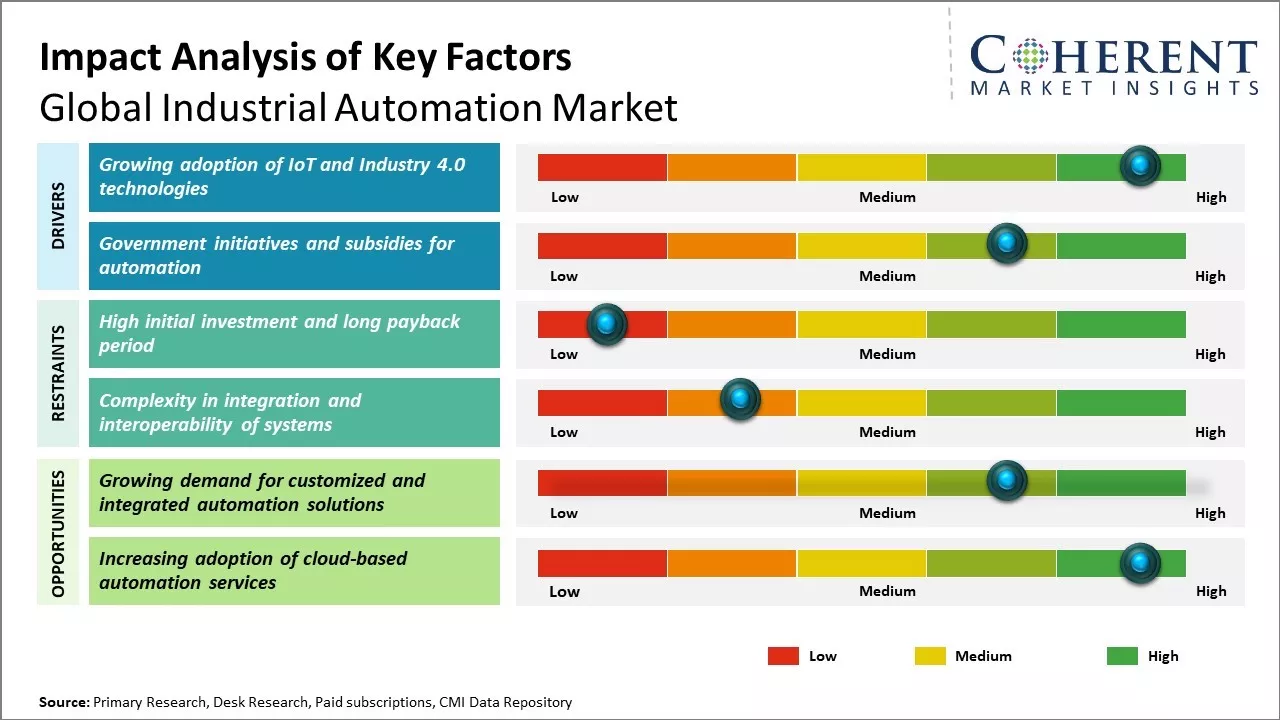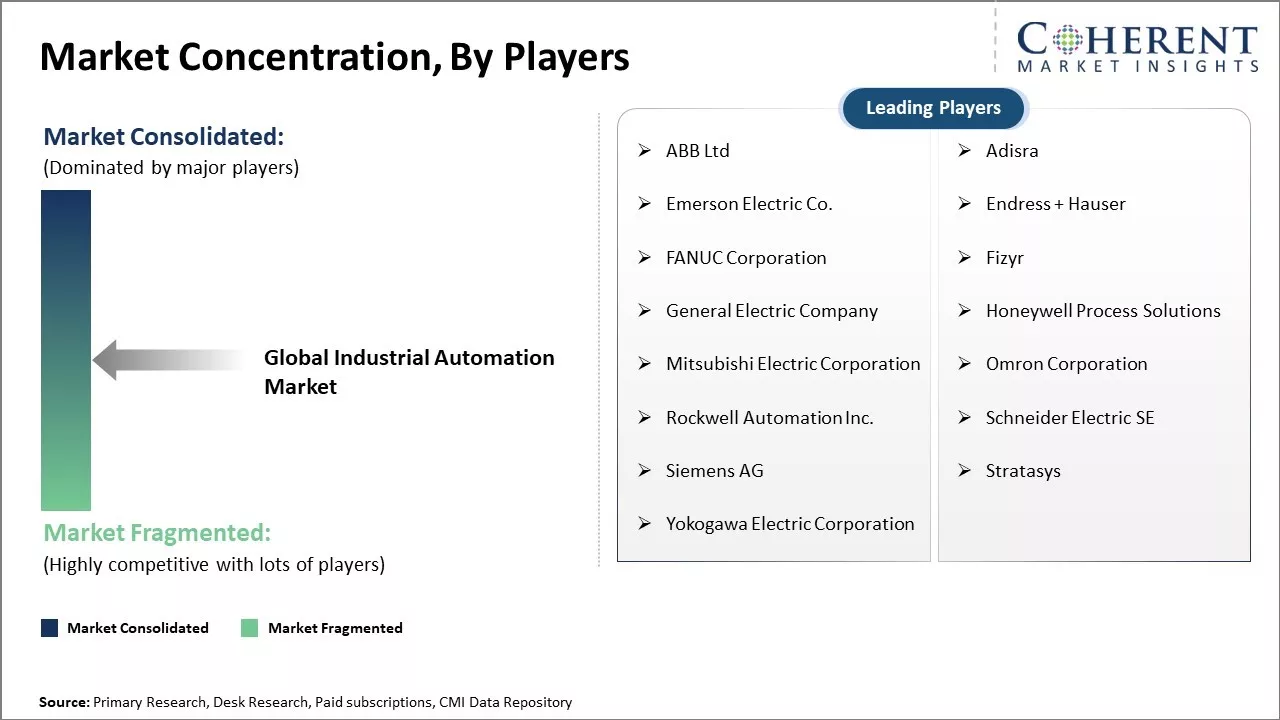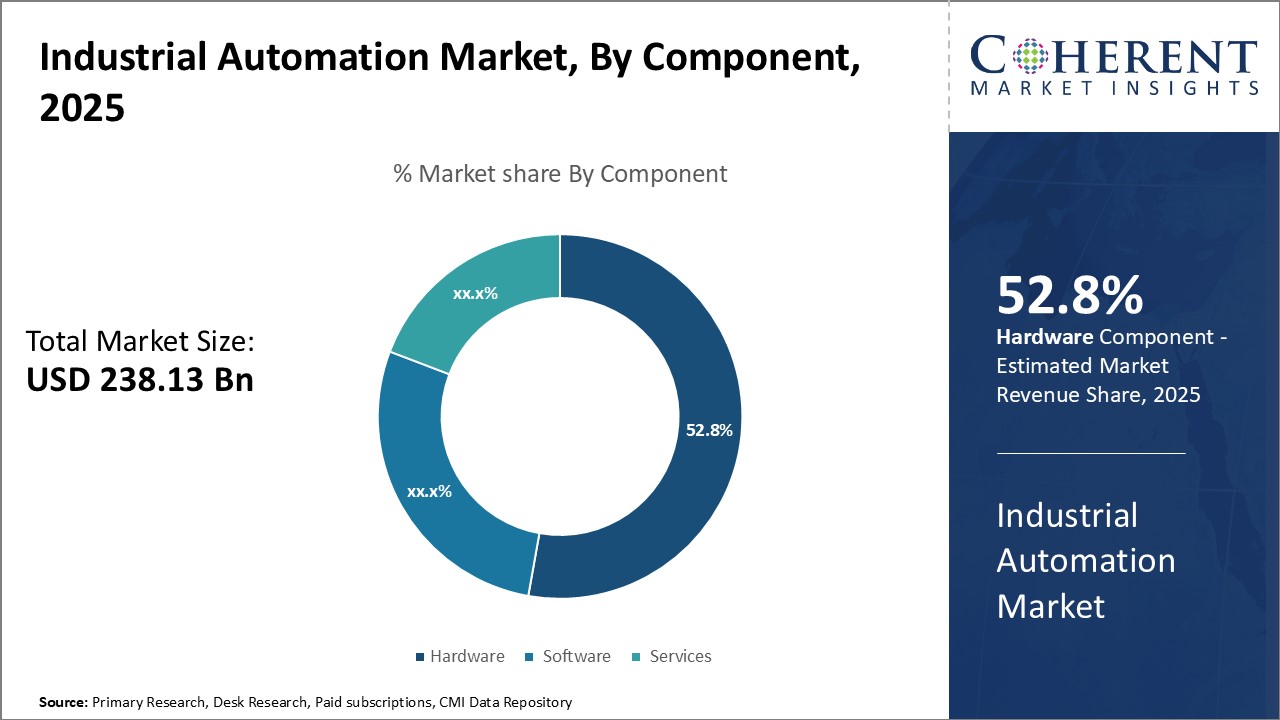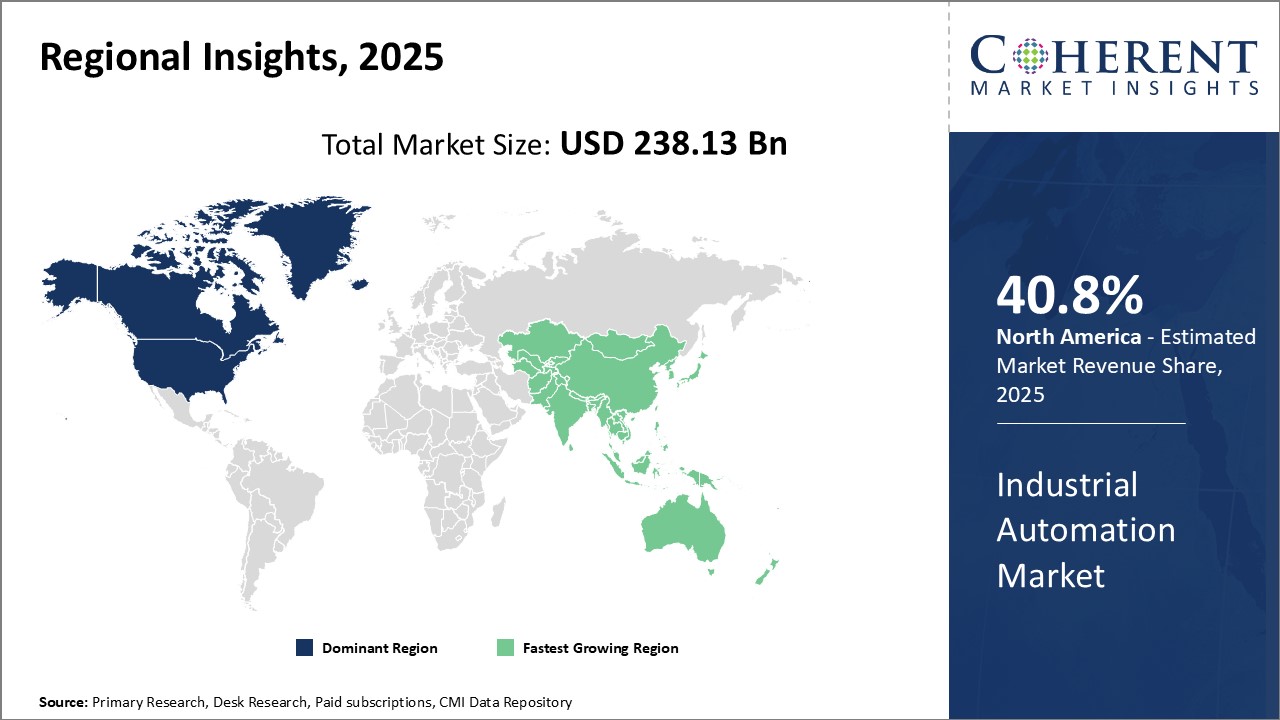Industrial Automation Market Size and Trends
Global industrial automation market is estimated to be valued at USD 238.13 Bn in 2025 and is expected to reach USD 449.77 Bn by 2032, exhibiting a compound annual growth rate (CAGR) of 9.5% from 2025 to 2032.

Discover market dynamics shaping the industry: Download Free Sample
Global industrial automation market growth is driven by rapid digitalization and rising adoption of industrial internet of things (IIoT) based solutions across industries.
The key trend in the industrial automation market has been increasing investments by manufacturers in adoption of advanced robotics and IoT based technologies to drive productivity and operational efficiency. Adoption of AI and machine learning in automation has also been growing globally. Enhanced data analytics capabilities and advance robotics solutions helps industries to optimize process management.
Growing adoption of IoT and Industry 4.0 technologies
Industrial revolution changed the landscape of industrial production by introducing mechanical manufacturing processes driven by steam and water power. Fourth Industrial Revolution is upon the manufacturing sector and promises to transform how goods will be produced once again. IoT and Industry 4.0 technologies that connect the physical world of factories and machines to controllers, software, sensors and people in an internet-based system enables increasingly intelligent and adaptive production. Manufacturers are realizing significant productivity gains from linking their physical operations to digital systems in ways that improve visibility into processes, optimize workflows, preempt downtime and enhance asset utilization.
Industry 4.0 technologies facilitate data collection from embedded sensors and machines on factory floors. This production data when analyzed with advanced analytics yields valuable insights into equipment performance, material usage and quality control. Manufacturers can predict maintenance needs, detect inefficiencies and orchestrate production flows in a more coordinated manner to maximize output. The connectivity afforded by IoT also allows for remote monitoring and management of industrial equipment. Issues can be addressed remotely before escalating to full breakdowns. The trove of operational intelligence gathered through IoT further aids in simulating “what if” scenarios to refine production processes.
Market Concentration and Competitive Landscape

Get actionable strategies to beat competition: Download Free Sample
Government initiatives and subsidies for automation
Governments across major economies like North America, Asia Pacific, etc. acknowledge that enabling advanced automation technologies for domestic manufacturers through initiatives and incentives is integral to sustaining their industrial competitiveness. Labor costs are increasing, while consumers demand higher quality, customized, and sustainable products at lower prices. These pressures can be mitigated by utilizing industrial robots and AI-driven systems. Governments provide tax relief, low interest loans and grants for manufacturers instituting industrial automation projects. For instance, “Industry 4.0” program by the Germany government co-funds R&D and implementation of smart factory technologies.
Government of Singapore also allocates funds through its “Automation Support Package” to help small businesses computerize operations. China’s “Made in China 2025” industrial plan commits billions in developing intelligent manufacturing capabilities. Tax credits are available in many American states for investments in industrial robotics. Canada and several European nations have similar subsidy drives promoting adoption of robotics. Such government assistance eases the upfront capital required for automation equipment and modernization. It encourages more organizations to invest in robotics, even during uncertain economic cycles.
For instance, in January 2021, Omron Corporation, a global leader in automation and control technology, launched the i4 series SCARA robot that is designed to automate high-precision, high-speed assembly and transportation processes. This innovative robot aims to enhance manufacturing efficiency by offering easy installation and advanced capabilities for various applications.
Key Takeaways from Analyst:
Rising need for mass production and minimization of errors pushes manufacturers to increase adoption of automation technologies across core manufacturing processes. Rising demand for enhanced productivity and quality prompt industries to integrate automated systems on their factory floors. Younger demographics also expect advanced robotics and AI solutions at their workplaces, and this boosts uptake of automation.
Reluctance from workers about job losses due to automation can hamper the market growth. High initial investments and maintenance costs of automation solutions pose significant budgeting hurdles for small and medium enterprises. Geo-political uncertainties due to trade wars also impacts spending appetite on capex.
Fourth industrial revolution can offer market growth opportunities. Growth of technologies like Internet of Things, additive manufacturing, and cloud computing create avenues for smarter and connected automation platforms. Adoption of collaborative robots provides flexibility while bridging skills gaps. The U.S. also shows potential due to rising factory modernization. Integration of IT and operational technology promises higher productivity and new revenue pools for early adopters of industrial automation.
Market Challenge - High initial investment and long payback period
Global industrial automation market growth can be hampered due to high initial investment and long payback period associated with industrial automation solutions. Investing in automation equipment requires considerable capital expenditure as industries have to purchase expensive robots, networked sensors, industrial computers and other hardware. The configuration and implementation of these advanced systems also involves high installation and engineering costs. For many small and medium scale industries, such large upfront investments are difficult to justify. The payback on automation investments generally ranges from 2 to 4 years depending on the industry and application. This long payback period acts as a deterrent for companies, especially those operating on thin margins. For automation to be economically viable, industries need sustained high production volumes over several years to offset the initial costs. Uncertainties in the market and frequent technology upgrades further complicate calculating the return on investment. Overcoming this challenge of high capital requirement and ensuring quicker payback will be critical for the widespread adoption of automation worldwide.
Opportunity- Growing demand for customized and integrated automation solutions
Global industrial automation market can witness growth opportunities due to growing demand for customized and integrated automation solutions from industries. With manufacturing becoming more complex, industries are looking for flexible and tailored automation systems that can seamlessly integrate with their existing production processes and infrastructure. There has been huge need for movable, modular solutions that can adjust according to changing business needs and market dynamics. Automation suppliers are focusing on developing configurable and programmable solutions that offer flexibility for minor adjustments in the production line even after installation. This has increased the emphasis on machine-to-machine communication technologies, distributed control systems and easy reprogramming features. Integrated platforms that combine robotics, analytics, artificial intelligence and other technologies are also gaining popularity. By offering application-specific solutions and value-added services, automation vendors can get customers to invest in customized and integrated automation projects.

Discover high revenue pocket segments and roadmap to it: Download Free Sample
Insights By Component - The Significance of the Hardware Segment in Industrial Automation Due to Its Essential Role in Operational Processes
In terms of component, hardware segment is estimated to contribute the highest market share of 52.8% in 2025, owing to its indispensability across operational processes. Hardware forms the backbone of any automated industrial system, comprising machines, tools, controllers and interface units that help translate digital commands into physical actions. Their widespread integration allows industries to augment productivity, quality and efficiency while reducing costs and human errors.
Programmable logic controllers or PLCs remain the prime hardware utilized for control, monitoring and automation applications. Their programmable nature permits flexible adjustments to production changes. Robust machinery such as robots and conveyor belts rely on for material handling tasks that need repeatability and speed. Moreover, safety devices such as light curtains are crucial hardware that protect both man and machine.
Insights By Technology - Rapid adoption of programmable logic controllers (PLC) segment due to its flexibility and reliability
In terms of technology, programmable logic controllers (PLC) segment is estimated to contribute the highest market share of 39.6% in 2025, owing to their user-friendly programming interface and robust design. PLCs have emerged as the default choice for controlling discrete and sequential automation processes across sectors. Their ladder logic programming makes sequencing applications intuitive for engineers to develop. Being solid-state electronic systems also make PLCs highly durable in harsh industrial environments compared to electromechanical controls.
The programmable nature of PLCs has boosted their popularity as it allows for on-site modifications to production flows without hardware redesigns. This has significantly reduced downtimes for industries undergoing facility upgrades or product changeovers. PLCs are scalable to cater for expansion or addition of new machines on the line. Their modularity permits distribution of logic over multiple controllers for larger and more complex systems. Manufacturers have increasingly adopted PLCs to integrate diverse automation equipment on the plant floor through common programming platforms.
Insights By Application - The Manufacturing Segment's Dominance Driven by Industrial Automation to Meet Mass Production Demands
In terms of application, manufacturing segment is estimated to contribute the highest market share of 37% in 2025, owing to the immense scale of operations that require automation for viability. Automating processes has helped manufacturing dramatically improve output volumes through streamlined workflows and real-time optimizations. Robots, conveyors, vision systems and other hardware have become ubiquitous in factories to facilitate high-speed and precisely coordinated production cycles.
Key manufacturing subsectors like automotive, electronics, chemicals and food & beverage leverage automation extensively to gain competitive edge. Automobiles rely on automated welding, painting and assembly lines running several robotic workcells. Discrete part manufacturers employ automated loaders, handlers and assembly workstations for tiny components. Process industries also automate continuous production extensively through advanced control systems, ensuring consistent quality and compliance.
Across the manufacturing value chain, automation has enabled 24/7 operations through lights-out and unmanned facilities. This enhances asset utilization towards flexible just-in-time production models. Automation also addresses labor challenges of manufacturers through improved ergonomics and the elimination of hazardous jobs. The ability to mass-produce quality products at an accelerated pace continues boosts adoption of industrial automation technologies in this sector.
Regional Insights

Need a Different Region or Segment? Download Free Sample
North America has established itself as the dominant region in the global industrial automation market with an estimated market share of 40.8% share in 2025. With strong manufacturing infrastructure and early adoption of advanced technologies, the U.S. and Canada have presence of many industry leaders and multinational companies in this field. Industries like automotive, electronics, food & beverages and oil & gas have boosted automation demand. The region has witnessed heavy investments by companies to upgrade plants with latest robots, sensors, machine vision systems and industrial IoT solutions.
For instance, In September 2022, ABB Ltd., a global technology leader in electrification and automation, expanded its manufacturing footprint in the U.S. by investing in new electric vehicle (EV) charger stations in the region. This investment is aimed at enabling ABB E-mobility to meet the growing demand for electric vehicle chargers across the area.
Support from the governments through initiatives such as Industry 4.0 has also boosting efficiency. These initiatives have focused on digitization of manufacturing processes via technologies like additive manufacturing, advanced robotics, big data analytics, and others. With higher productivity needs, North American manufacturers export majority of automation solutions to other regions. Leading vendors have established local manufacturing and strong distribution channels to effectively cater to regional clients. High premiumization along with technological superiority has ensured highest sales realizations as compared to other markets globally.
Asia Pacific region has emerged as the fastest growing market for industrial automation. Countries like China, Japan, South Korea and India witness growth due to robust manufacturing led economies. While the automotive, electronics and heavy machinery industries in developing nations like China and India offer significant untapped opportunities, developed Asian countries are focusing on factory digitization through Industry 4.0 upgrades. Japanese manufacturers are renowned for innovative process automation solutions globally.
Growing foreign investments as well as government initiatives promoting manufacturing are boosting efficiency. Affordable labor costs have encouraged global industrial leaders to establish production bases in Asia to take advantage of economies of scale. Rising wages are now pushing companies to rapidly automate manufacturing processes. Led by China, the industrial automation landscape in Asia is evolving at a rapid pace through adoption of world-class automation technologies and solutions.
Market Report Scope
Industrial Automation Market Report Coverage
| Report Coverage | Details | ||
|---|---|---|---|
| Base Year: | 2024 | Market Size in 2025: | USD 238.13 Bn |
| Historical Data for: | 2020 To 2024 | Forecast Period: | 2025 To 2032 |
| Forecast Period 2025 to 2032 CAGR: | 9.5% | 2032 Value Projection: | USD 449.77 Bn |
| Geographies covered: |
|
||
| Segments covered: |
|
||
| Companies covered: |
ABB Ltd, Adisra, Emerson Electric Co., Endress + Hauser, FANUC Corporation, Fizyr, General Electric Company, Honeywell Process Solutions, Mitsubishi Electric Corporation, Omron Corporation, Rockwell Automation Inc., Schneider Electric SE, Siemens AG, Stratasys, Yokogawa Electric Corporation |
||
| Growth Drivers: |
|
||
| Restraints & Challenges: |
|
||
Uncover macros and micros vetted on 75+ parameters: Get instant access to report
Market Segmentation
- By Component Insights (Revenue, USD Bn, 2020 - 2032)
- Hardware
- Software
- Services
- By Technology Insights (Revenue, USD Bn, 2020 - 2032)
- Programmable Logic Controllers (PLC)
- Supervisory Control and Data Acquisition (SCADA)
- Distributed Control Systems (DCS)
- Human-Machine Interface (HMI)
- Industrial Robotics
- By Application Insights (Revenue, USD Bn, 2020 - 2032)
- Manufacturing
- Oil and Gas
- Energy and Power
- Chemicals
- Food and Beverages
- Pharmaceuticals
- By Regional Insights (Revenue, USD Bn, 2020 - 2032)
- North America
- U.S.
- Canada
- Latin America
- Brazil
- Argentina
- Mexico
- Rest of Latin America
- Europe
- Germany
- U.K.
- Spain
- France
- Italy
- Russia
- Rest of Europe
- Asia Pacific
- China
- India
- Japan
- Australia
- South Korea
- ASEAN
- Rest of Asia Pacific
- Middle East
- GCC Countries
- Israel
- Rest of Middle East
- Africa
- South Africa
- North Africa
- Central Africa
- North America
- Key Players Insights
- ABB Ltd
- Adisra
- Emerson Electric Co.
- Endress + Hauser
- FANUC Corporation
- Fizyr
- General Electric Company
- Honeywell Process Solutions
- Mitsubishi Electric Corporation
- Omron Corporation
- Rockwell Automation Inc.
- Schneider Electric SE
- Siemens AG
- Stratasys
- Yokogawa Electric Corporation
Share
Share
About Author
Ramprasad Bhute is a Senior Research Consultant with over 6 years of experience in market research and business consulting. He manages consulting and market research projects centered on go-to-market strategy, opportunity analysis, competitive landscape, and market size estimation and forecasting. He also advises clients on identifying and targeting absolute opportunities to penetrate untapped markets.
Missing comfort of reading report in your local language? Find your preferred language :
Transform your Strategy with Exclusive Trending Reports :
Frequently Asked Questions
EXISTING CLIENTELE
Joining thousands of companies around the world committed to making the Excellent Business Solutions.
View All Our Clients
